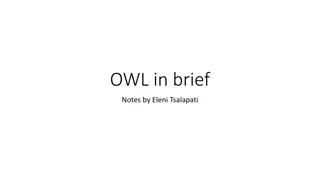Ontology-Driven Review-Level Aspect-Based Sentiment Analysis
This study presents an innovative approach to sentiment analysis at the review level, focusing on aspect-based sentiment analysis (ABSA) using ontologies. Motivated by the increasing volume of product reviews online, the research addresses the challenge of detecting sentiment associated with aspects in product reviews. By leveraging Ontology-Driven Machine Learning, the study explores both explicit and implicit aspect detection and sentiment assignment. Evaluation results showcase the effectiveness of the proposed approach in automating sentiment analysis for improved decision-making in e-commerce.
Download Presentation

Please find below an Image/Link to download the presentation.
The content on the website is provided AS IS for your information and personal use only. It may not be sold, licensed, or shared on other websites without obtaining consent from the author.If you encounter any issues during the download, it is possible that the publisher has removed the file from their server.
You are allowed to download the files provided on this website for personal or commercial use, subject to the condition that they are used lawfully. All files are the property of their respective owners.
The content on the website is provided AS IS for your information and personal use only. It may not be sold, licensed, or shared on other websites without obtaining consent from the author.
E N D
Presentation Transcript
Review-Level Aspect-Based Sentiment Analysis Using an Ontology Flavius Frasincar* frasincar@ese.eur.nl * Joint work with Sophie de Kok, Linda Punt, Rosita van den Puttelaar, Karoliina Ranta, and Kim Schouten 1
Contents Motivation Related Work Data Methodology Evaluation Conclusion Future Work 2
Motivation Due to the convenience of shopping online there is an increasing number of Web shops Web shops often provide a platform for consumers to share their experiences, which lead to an increasing number of product reviews: In 2014: the number of reviews on Amazon exceeded 10 million Product reviews used for decision making: Consumers: decide or confirm which products to buy Producers: improve or develop new products, marketing campaigns, etc. 3
Motivation Reading all reviews is time consuming, therefore the need for automation Sentiment mining is defined as the automatic assessment of the sentiment expressed in text (in our case by consumers in product reviews) Several granularities of sentiment mining: Review-level Sentence-level Aspect-level (product aspects are sometimes referred to as product features): Aspect-Based Sentiment Analysis (ABSA): Review-level [our focus here] Sentence-level 4
Motivation Aspect-Based Sentiment Analysis (ABSA) has two stages: Aspect detection: Explicit aspect detection: aspects appear literally in product reviews Implicit aspect detection: aspects do not appear literally in the product reviews Sentiment detection: assigning the sentiment associated to explicit or implicit aspects [our focus here] Main problem: In previous work we have proposed an approach to detect the sentiment for an aspect at sentence-level How to find the sentiment for an aspect at review-level? 5
Main Idea and Evaluation Result Approach: Ontology-Driven Machine Learning (Multi- class classification with ontology-related features) Ontologies advantages: Deal with small training data Use axioms to derive implicit information Two solutions: 1. Use a classifier to predict the aspect-based sentiment at review level 2. Use a classifier to predict the aspect-based sentiment at sentence level and aggregate the sentiment 6
Main Idea and Evaluation Result Collection of restaurant reviews from SemEval 2016 Evaluation result 1: The review-level approach has an F1 of 81.19% on test data The sentence-level approach has an F1 of 77.17% on test data There is a 4.02 percentage points increase in F1 for the review-level classifier compared to the sentence-level classifier Evaluation result 2: With ontology features the review-level approach F1 increases from 80.20% to 81.19% on test data With ontology features the sentence-level approach F1 increases from 68.24% to 77.17% on test data Using the ontology features both classifiers get a better F1 with a larger increase for the sentence-level classifier compared to the review-level classifier 7
Related Work (Schouten et al., 2017): Uses a sentiment ontology and an SVM for classification Find ontology concepts associated for review words and related to the considered aspect, and add superclasses as ontology features No treatment of synonyms and does only sentence-level ABSA (Wei and Gulla, 2010): Uses a Sentiment Ontology Tree (SOT) where aspect nodes form a hierarchy and there are two leaf nodes (positive and negative) for each internal node Learns a classifier for each leaf node (Lau et al., 2009): Uses a sentiment ontology and manually crafted NLP rules for classification 8
Data SemEval 2014 dataset: restaurants reviews Training set: 335 reviews: 1435 review-aspect pairs 2455 sentence-aspect pairs Test set: 90 reviews: 404 review-aspect pairs 859 sentence-aspect pairs Each review-aspect pair is annotated with sentiment: positive, negative, neutral, or conflict Each review-aspect pair is annotated with sentiment: positive, negative, or neutral A sentence or review can contain multiple aspects Task: detect the aspect-based sentiment at review-level 9
Relative Frequencies of Aspects in Reviews RESTAURANT#GENERAL has a frequency of 100% (present in all reviews) 10
Relative Frequencies of Sentiment in Reviews Unbalanced sentiment distribution (Positive labels are the most frequent) 11
Methodology Multi-class classifier: linear SVM (shown to give good results for sentiment analysis in literature) Review-level: 4 classes (positive, negative, neutral, and conflict) Sentence-level: 3 classes (positive, negative, and neutral) SVM implementation: Weka, one-versus-one Data processing: Stanford CoreNLP Toolkit Tokenization Part-of-Speech Lemmatization Grammatical dependencies Ontology gazeteering 12
Ontology Available online: http://www.kimschouten.com/papers/sac2018- ontology.owl (manually created using the training set and three external resources http://quizlet.com , http://www.macmillandictionary.com/, and https://wordnet.princeton.edu/) Three main classes: Entity class with subclasses (noun aspect hierarchy): Ambience, Experience, Location, Person, Price, Restaurant, Service, StyleOptions, and Sustenance which have their own subclasses The aspect relation links an entity class with its corresponding aspect (e.g., FOOD#QUALITY) Property class (adjectives): Generic properties (e.g., GenericPositiveProperty): general positive or negative properties related to many Entity classes Entity-specific properties (e.g., AmbienceNegativeProperty): specific positive or negative properties for one Entity class (e.g., subclass of Property and subclass of Ambience) Sentiment class with subclasses Positive, Negative, and Neutral 13
Ontology Context specific sentiment properties: these properties (e.g., Cold) in combination with an entity (e.g., WarmDrinks) imply a subclass of sentiment (e.g., Negative) 14
Example Let assume that the word cramped appears in text lex.{ cramped } Cramped Cramped AmbienceNegativeProperty AmbienceNegativeProperty Ambience AmbienceNegativeProperty Negative Ambience aspect.{ AMBIENCE#GENERAL } Thus cramped implies a negative sentiment about the aspect AMBIENCE#GENERAL 15
Two Algorithms 1. Use a linear SVM classifier to predict the aspect-based sentiment at review level: Four classes: positive, negative, neutral, and conflict 2. Use a linear SVM classifier to predict the aspect-based sentiment at sentence level and aggregate the sentiment: Three classes: positive (1), negative (-1), and neutral (0) Aggregation: Compute the average sentiment for an aspect If both positive and negative sentiment is present for an aspect then the overall sentiment for this aspect is conflict Otherwise: If average sentiment for an aspect is 0 then the overall sentiment for this aspect is neutral Otherwise the overall sentiment for this aspect is given by the sign of the average sentiment for an aspect (positive or negative) 16
Model Features Feature Generators: create one or more features [Ontology Independent] Aspect: the aspects present in a sentence/review Sentence count: the number of sentences in a review Lemma: the words present in a sentence/review [Ontology Dependent] Ontology concepts: If a concept lexicalization is found in a sentence/review and one of the superclasses relates to the current aspect category then add all superclasses as features Sentiment count: Whenever a concept lexicalization is found and the associated concept is a subclass of Positive or Negative, then increment the respective counter feature (positive or negative) 17
Model Features Feature Adaptors: adapt existing features [Ontology Dependent] Ontology concept score: multiplies the ontology concept score with 1 (for superclasses that do not relate to the current aspect category) or m >1 (for superclasses that do relate to the current aspect category) Negation handling: for the sentiment count,an ontology hit word that has a negation word in front of it negates the sentiment class of the associated concept Synonyms: for the ontology concepts, use the WordNet synonyms in addition to a given concept lexicalization (for a given domain there is in general only one WordNet synset associated to a concept) 18
Model Features Feature Adaptors: adapt existing features [Ontology Dependent] Weight: for the ontology concepts use the TF-IDF of the associated lexicalization of the superclasses of a found ontology concept Word window: for the feature generators,when a concept lexical representation is found (including synonyms) we use as textual unit (context) the words at most k grammatical dependency steps away 19
Evaluation Collection of restaurant reviews from SemEval 2016 We use the average F1 score for 10-fold cross-validation on the training data to determine the parameters and set of features Review-level approach: base (no ontology features): feature generators aspect, sentence count, and lemma final (with ontology features): feature generators aspect, sentence count, lemma, ontology concepts, and sentiment count, and feature adaptors: negation handling, synonyms, and weight For both model the optimized complexity parameter was c=0.1 20
Evaluation Review-level approach: The final review-level model (i.e., w/ ontology features) performs better than the base review-level model (i.e., w/o ontology features) for both training and test sets 21
Evaluation Sentence-level approach: baseSL (no ontology features): feature generators aspect and lemma ontSL (with ontology features): feature generators aspect, lemma, ontology concepts, and sentiment count, and feature adaptors: ontology concept score, negation handling, synonyms, weight, and word window Parameters: The ontology concept score parameter was m = 5 The word window parameter was k = 2 The optimized complexity parameter was c = 1 for baseSL and c = 0.1 for ontSL 22
Evaluation Sentence-level approach: sentence The ontology-based sentence-level model performs better than the base sentence-level model (i.e., w/o ontology features) for both training and test sets at sentence level 23
Evaluation Sentence-level approach: review The ontology-based sentence-level model performs better than the base sentence-level model (i.e., w/o ontology features) for both training and test sets at review level The gold value is an upper bound of F1 when using the gold annotations at sentence level 24
Evaluation SemEval 2016 ranking (on test set): 25
Evaluation There is a 4.02 percentage points increase in F1 for the review-level classifier compared to the sentence- level classifier Using the ontology features both classifiers get a better F1 with a larger increase for the sentence-level classifier compared to the review-level classifier The accuracy difference of the review-level classifier to the best performing SemEval 2016 classifier is less than 1 percentage points 26
Evaluation Data size sensitivity (on test set): 10 runs on training set The ontology gives better results for all training data sizes The ontology boost seems not to depend on the training data size 27
Evaluation Top 10 most important features for the final review-level model based on to information gain (feature generator: feature) Most features relate to the dominant class (Negative) The top 80 features with the largest SVM weight are all ontology features such Negative, Boring, and Cozy 28
Conclusion We proposed two algorithms for review-level aspect- based sentiment analysis: Review-based algorithm Sentence-based algorithm The review-based algorithm performs better than the sentence-based algorithm The use of ontology features boosts the performance of both algorithms The ontology performance boost seem not to depend on the size of the training data 29
Future Work Apply a two step approach: Use ontology reasoning first If ontology inconclusive, apply SVM without ontology features (worked well for sentence-based sentiment analysis, results to be presented at ESWC 2018) Automatic creation of the ontology from text Extend the ontology coverage using word embeddings Extract the strength of a sentiment instead of just the polarity: positive, negative, neutral, and conflict Replace the SVM classifier with a deep learning solution 30























